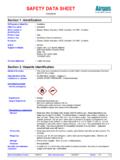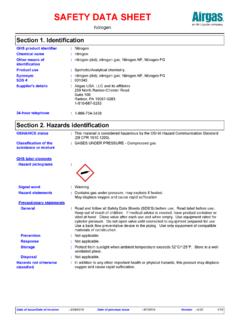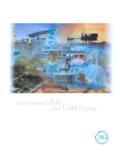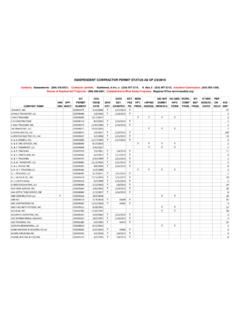Transcription of Aqua Ammonia Info Manual - Airgas
1 10 aqua AMMONIAC hemical PropertiespHAqua Ammonia (ammonium hydroxide) isclassified as a weak base. It ionizes much lesscompletely in water than does a strong base suchas sodium hydroxide. This is reflected in the pH snormally encountered with solutions of , the pH of an Ammonia solution will bebetween 11 and 12, compared with a pH of about14 for sodium hydroxide solutions. Thetheoretical pH s below are for Ammonia in purewater at 77 Constants (Kb s) of aqua AmmoniaFrom 0 C to 50 CTemperature x x x x x x x x x x x 10-5 , determined by emf method by Batesand PinchingNote: pKb = pKw-pKawhere pKw = 14 and pKa = [H+]{NH3]/[NH4+]Heat of SolutionWhen liquid anhydrous Ammonia is dissolved inwater, heat is liberated which varies with the finalconcentration of aqua Ammonia Wt % NH3 BTU/lb.}
2 Ammonia will react with many organic andinorganic acids to form ammonium salts andcompounds; with certain metals to form complex-ion salts; with halogens to form haloamines (suchas its reaction with sodium hypochlorite [bleach]to form toxic chloramines); and under extremecircumstances with silver and mercury to formexplosive Ammonia corrodes copper (and copper-containing alloys such as brass), zinc, cadmiumand chemical corrosivity information, see theMaterials Compatibility section on page PropertiesAqua Ammonia is a clear, colorless liquid having astrong pungent Ammonia GravityThe specific gravity of aqua Ammonia iscustomarily expressed as its density at 60 Fcompared to the density of water at 60 tables of specific gravity, as well ascorrections to use for temperature variations, arepresented on pages 16-20 in Appendix A.
3 11 Weight %Specific GravityDegreesAmmoniaat 60 F/60 FBaum %Specific GravityDegreesAmmoniaat 60 F/60 FBaum of Ferguson from Lange s Handbook ofChemistry (5th Edition).PressureThe total vapor pressure of an aqua ammoniasolution is comprised of the partial vapor pressuredue to NH3plus the partial vapor pressure due toH2O. Information on these pressures as afunction of temperature is provided in AirgasTechnical Bulletin TB-9-1, which is reproduced inAppendix A, page 21. More comprehensive tablesof this relationship are presented in Appendix A,pages 22-25. Note that any pressure due to thepresence of air in a storage tank or system isadditional to the aqua Ammonia vapor pressure.
4 12 aqua AMMONIAS olubilityWater and Ammonia are miscible in allproportions. When one refers to the solubility ofammonia in water, it is usually meant to be thesolubility at a given temperature for which thevapor pressure is equal to atmospheric FWt. % Ammonia a graph of solubility vs. temperature, seeAppendix A, page 26 Freezing PointThe freezing point of Ammonia is about -111 FWeight Percentof Ammonia inAqua AmmoniaFreezing Point Percentof Ammonia inAqua AmmoniaFreezing Point I: II: III: : S. Postma Recveil des Travaux Chimiguesdes Pays-Bas 39,515 (1920)For a graph of freezing point versus temperature,see Appendix A, page 27. 13 Boiling PointThe boiling point of aqua Ammonia is defined asthe temperature at which the partial vaporpressure of the Ammonia vapor over the aquaammonia equals atmospheric Be Weight % NH3 Boiling Point at 60 Concentration Ammonia viscosity is higher than that forliquid anhydrous Ammonia .
5 The viscosities shownbelow are for 26% concentration aqua Perry s Chemical Engineer s Handbook(1984)Surface TensionThe surface tension of aqua Ammonia at 67 F forvarious concentrations is shown below:% NH3 Surface Tension (dynes/cm) Perry s Chemical Engineer s Handbook(1984)ConversionsDilutionsThe calculations required to determine the volumeof anhydrous Ammonia or aqua Ammonia of aninitial concentration to mix with water to create aspecific concentration aqua Ammonia do notfollow normal dilution rules since the anhydrousammonia and aqua Ammonia volumes are notadditive with water volumes, , one gallon ofanhydrous Ammonia added to nine gallons ofwater does not result in 10 gallons of final volume would be less than 10 many aqua dilutions, the non-additive effectsare minimal.
6 For anhydrous additions, they steps to calculate dilutions are as follows:1. Let Vo= volume in gallons of original concentration aqua Ammonia oranhydrous ammoniaCo= concentration in wt. % NH3ofanhydrous Ammonia or original aquaammonia solution usedVf= volume in gallons of final solutiondesiredCf= concentration in wt. % NH3offinal aqua Ammonia solution desiredVw= volume in gallons of water to beadded2. Determine specific gravities at 60 F/60 F ofboth original and final concentrations of aquaammonias by referring to tables in PhysicalProperties on page 11. Interpolation is used to



